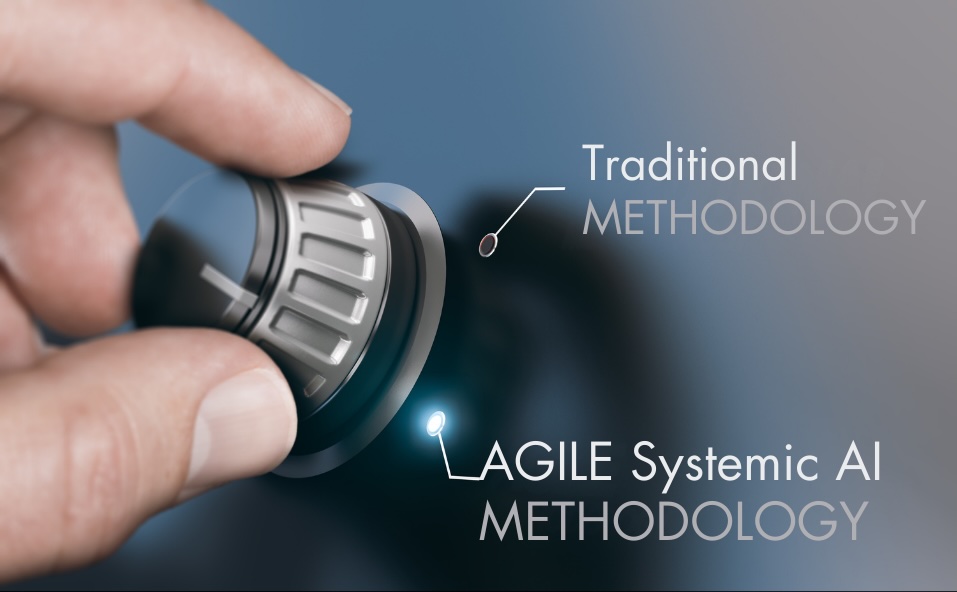In future, the decisive competitive advantage for your business will be based on a powerful equation: systems thinking + artificial intelligence + agile processes. Companies that combine these three pillars are much more likely to survive – and even dominate – today’s volatile markets. Recent studies by global consulting firms predict AI-related improvements in operational agility of several trillion dollars by 2030. With the right approach, your company can also benefit greatly from this.
However, for many medium to large manufacturers and service providers, the leap from theory to practice can initially feel daunting given the significant challenges. The good news is that with the right framework, this shift can be both quick and highly impactful. Below is a concise, proven and strategically sound five-step approach to harnessing the AI wave. This is based on the principles of systems thinking and is supported by agile methods.
Numerous automotive suppliers, machine builders, food processors, real estate managers and many others have already embarked on this journey with us.
Systems thinking + artificial intelligence + agile processes are now becoming a “Game-Changer”.
1. The “Systems Thinking” Mindset – Systems Thinking 2.0
Why is this important?
In an era of highly interconnected value chains and razor-thin profit margins, local ‘quick fixes’ without a holistic approach can do more harm than good. Systems thinking enables leaders to see the big picture – how raw materials, production processes, technology, teams and customers interact in a broader ecosystem.
Practical Application
- First, map out your value streams: Identify systemic bottlenecks (e.g. a slow feedback loop between R&D and production). Use tools such as system maps or causal loop diagrams to visualize dependencies.
- Break down organizational silos: Encourage a transparent exchange between departments. AI is at its best when it draws on different data sources, from stock levels to customer feedback.
Positive Results
By integrating predictive AI models with real-time supplier data, an automotive supplier was able to reduce lead times by 20% and significantly reduce inventory costs.
2. Using AI as a powerful “lever” instead of a “savior”
Why is this important?
Be realistic when using AI, because it will only help your company extraordinarily if you apply the “lever” in the right places. AI can improve, accelerate and optimize (almost) everything, from predictive maintenance to robot production. However, simply installing AI systems without a clear strategy often leads to various pilot projects where a proof-of-concept is not translated into sustainable results. The right strategy is therefore crucial to achieve real added value with AI initiatives.
Practical Application
- Identify high value-added opportunities: Conduct a thorough (but quick) assessment to identify areas where AI can bring immediate benefits, be it reducing product defects, optimizing work preparation or more effective marketing
- Invest in data provision: AI is only as good as the data it has available. Ensure your data pipelines are accurate, up-to-date and securely managed.
- Build cross-functional AI teams: Bring together data and AI experts and experienced operational staff to ensure that AI models solve real operational problems, rather than focusing predominantly on peripheral issues.
Positive Results
With AI-driven anomaly detection, a well-known manufacturer was able to find the smallest defects in drive components. The result was a 78% reduction in the reject rate, which also boosted their reputation on the market enormously.
3. Agile methods for an accelerated introduction of artificial intelligence
Why is this important?
Modern manufacturing must be able to react quickly to fluctuating consumer demand, disruptions in (global) supply chains and the possibilities offered by the use of AI technologies. Agile methods such as Scrum, Kanban or hybrid sprint frameworks enable rapid iterations, cross-functional collaboration and continuous learning.
Practical Application
- Small, cross-functional sprints: Develop AI-driven improvements in short, iterative cycles. Involve production managers, software engineers and data scientists from day one.
- Frequent feedback loops: Hold regular retrospectives to refine processes. Encourage a “fail fast, learn faster” mentality – an approach that has propelled leading technology companies to the top of the world.
- Visible progress and quick wins: Show tangible results early on. This not only secures stakeholder buy-in, but also creates momentum for larger projects.
Positive Results
A machine builder used two weeks to build an AI model for predictive maintenance. By demonstrating incremental benefits early on – such as a 15% reduction in downtime – management gave the green light for wider AI initiatives across the production line.
4. Scaling artificial intelligence through a robust transformation framework
Why is this important?
Once a pilot project has proven successful, the real value comes from scaling and expanding to larger parts of the company, entire plants, product lines or regions. An agile approach to scaling ensures that each growth step is also iterative but continuously aligned with overarching strategic goals.
Practical Application
- Establishment of an Enterprise AI Center of Excellence: centralization of best practices, governance and knowledge sharing around AI. Smaller companies can also use an experienced strategic service provider for this.
- Standardize processes and tools: Use common platforms, coding standards and data taxonomies to avoid fragmentation across different locations or departments.
- Align with strategic KPIs: Make sure your AI roadmap aligns with the company’s top goals – be it revenue growth, market expansion or sustainability.
Positive Results
A medium-sized industrial manufacturer used a standardized AI toolbox for its factory and administration. By methodically repeating best practices, the company achieved consistent improvements – mostly double-digit productivity increases on each new production line added.
5. A culture of continuous learning
Why is this important?
AI models are evolving, market conditions are changing and technologies are emerging at a rapid pace. A static approach ensures that what is innovative today may be outdated tomorrow. Building a culture of continuous learning keeps your company at the cutting edge.
Practical Application
- Ongoing training: Provide regular training in AI, data analytics and agile best practices. Encourage employees at all levels to adopt a digital-first mentality.
- Reward experimentation: Celebrate innovative ideas – even if they fail – as long as the lessons learned are incorporated into the next iteration.
- Monitor, measure, improve: Use analytics tools to continuously track key performance metrics. Optimize AI models and workflows as insights evolve.
Positive Results
With the help of an experienced strategic partner, a German food processor set up an “AI lab” – a small innovation center where engineers, data scientists and production staff work together on process improvements. This continuous R&D mentality reduced the time to market for new products by 45% within three years.
The urgency to act – and why AVECU is your reliable partner
The era of AI-driven management and manufacturing has arrived, and it is closely intertwined with holistic systems thinking and agile operations. Early adopters are reaping exponential gains – from small pilot projects to large-scale transformations that redefine entire product lines, supply chains and even business models.
At AVECU, we specialize in guiding medium to large manufacturers on this transformative journey. Our unique combination of strategic understanding, AI expertise and practical Agile frameworks ensures that you realize tangible value quickly while laying the foundation for long-term competitiveness.
Strategy leaders and executive teams: We help you find a clear path from isolated pilot projects to integrated AI initiatives that align with your key KPIs and investor expectations.
Operations leaders & plant managers: We streamline production with AI-driven process improvements and Agile best practices tailored to your context.
Innovation leaders & IT departments: We combine cutting-edge AI solutions with a robust IT infrastructure to ensure secure, scalable and data-driven operations.
Now is the time to jump on the AI wave. Get in touch with us to learn how we can catapult your business into a new era of profitability, resilience and sustainable innovation. Let’s work together to create a truly future-proof manufacturing ecosystem – one that adapts, evolves and thrives in the age of AI.



